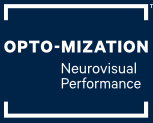
Vision Conditions
Neurovisual training can support a number of vision conditions, including:
Amblyopia (Lazy Eye)
Amblyopia refers to a loss of vision in the eye that is not correctable by lenses but is also not due to actual damage to the photoreceptors or optic nerves.
Amblyopia can be caused by strabismus (eye turn), obstruction, or a significant difference in prescription. This happens because vision is a learned skill and will not develop properly without the right conditions.
If the brain is ignoring the eye during critical periods of development the ability to “see” through that eye will be compromised.
Amblyopia will affect the efficiency of the visual system (as it loses the advantage of being binocular). This is a major part of reading and learning as well as coordinating one’s actions for sports and navigating through one’s surroundings. Patients with amblyopia will have some level of depth perception but it will be greatly reduced.
Recent findings have shown that amblyopia treatment can take place at any age (although it may take a little longer. It used to be believed (and still is in some circles) that patching was the only way to treat amblyopia because patching forces the brain to pay attention to the weaker eye. While patching can lead to some improvement in what the amblyopic eye can see, it does not necessarily improve the ability to use both eyes together. Patching can also be a very difficult procedure with patients young and old because it is uncomfortable and cosmetically challenging.
Often, after patching regimens, the amblyopic eye has shown an improvement in acuity (letters on the chart) but the brain is still not using both eyes together in an efficient and accurate manner. (See the Binocular Vision page). This can cause difficulties in reading and learning, sports, depth perception, and symptoms such as headaches.
Neurovisual training both builds the visual skills of the affected eye on its own — and both eyes together — so that the brain can be taught to pay attention to and use both channels of input.
Brain Injury
Brain Injury can be caused by physical trauma (whiplash; concussions) or cerebrovascular accidents (strokes, lack of oxygen, or similar).
Even when an MRI or CT scan shows no physical damage, the pathways that are responsible for our vision <> can be interrupted and damaged. PTVS or Post Trauma Vision Syndrome can be commonly found after concussions, whiplash, or even severe emotional trauma.
We possess two different visual systems for incoming information. One is the focal system and is responsible for the “20/20” vision, and the small central area of your vision.
The other is called the peripheral system and is responsible for the information used in motor planning, balance, determining where to focus and how to compare the information from the two eyes. Approximately 20% of the incoming visual pathways are not used for your central vision, but instead go to areas of the brain responsible for balance and motor planning.
Very often in brain injury or PVTS there is a mismatch between how the information is used from these two systems.While many patients may pass all tests in terms of the focal system, the mismatch between the focal and peripheral system can leave them with many symptoms and difficulties. This is a frustrating experience for many patients as they are repeatedly told their vision is ‘fine’.
Signs/Symptoms of Brain Injury
Due to the complexity of the system a person with a brain injury or PTVS may experience a wide variety of symptoms. As each brain injury is unique, these symptoms may appear:
- Sensitivity to light
- Sensitivity to patterns
- Double vision
- Swimming sensations or moving backgrounds
- Moving objects appearing to have a trail behind them
- Not being able to focus for periods of time
- Difficulty changing point of focus
- Headaches or Migraines
- Poor hand-eye coordination
- Reduced peripheral vision
- Dizziness/nausea
- Poor depth perception
Treatment may involve the use of various Ergoptics™ lenses as well as effectively re-training the brain through Opto-mization™ Training to accurately process the information and control the visual system.
Convergence Insufficiency
Convergence Insufficiency is one of the most common eye disorders to affect reading and learning. It is not a problem with the muscles of the eyes or the nerves, but rather in how the brain controls the eye position. Signs and symptoms include:
- Eyestrain (especially with or after reading)
- Headaches
- Blurred vision
- Double vision
- Inability to concentrate
- Short attention span
- Frequent loss of place
- Squinting, rubbing, closing or covering an eye
- Sleepiness during the activity
- Trouble remembering what was read
- Words appear to move, jump, swim or float
- Problems with motion sickness and/or vertigo
For many sufferers, the main symptom is an avoidance of near-work activities. As with other visual issues, it is not a condition that is always ‘felt’ in the eyes. Frequently, if a child is having difficulty completing work up close and/or has trouble staying on these tasks due to discomfort, there is a misdiagnosis of ADD/ADHD. In fact, one study found that children who had been diagnosed with ADD/ADHD were three times more likely to have convergence insufficiency. (Granet DB, Gomi CF, Ventura R, Miller-Scholte A. The relationship between convergenceinsufficiency and ADHD. Strabismus. 2005;13:163–8. [PubMed])
Neurovisual training has provided the largest success rates and best resolution of symptoms, according to the Convergence Insufficiency Treatment Trial [Link to CITT study]. Interestingly, trial also demonstrated that ‘pencil pushup’ exercises often prescribed by traditional optometrists were not effective.
Double Vision
Vergence is how you move your eyes in or out to look at objects at different distances. If your eyes are not coordinated and pointing in the same place, you can experience double vision. Double vision not only causes confusion, but can also lead to misalignment of the eyes (phorias), strabismus, image suppression and amblyopia.
If an individual exhibits extra effort to maintain single and clear vision, symptoms usually worsen over time. Unfortunately, some people (particularly children) develop adaptation strategies to cope with these problems, like avoidance or amblyopia – but the visual system will fatigue and break down as the brain fights between either keeping the image clear, but double, or keeping the image fuzzy and single.
Irlen Syndrome
Irlen Syndrome is a sensitivity to pattern glare or high contrast lines. Sufferers diagnosed with Irlen Syndrome are typically prescribed different coloured lenses to reduce the sensitivity.
However, recent research (read here) has shown that Irlen Syndrome is caused by an underlying condition where your eyes and your brain are not working properly together. Therefore, when Irlen Syndrome sufferers are treated with neurovisual training, the need for Irlen lenses is reduced if not eliminated and the improvements are even more significant.
Ocular Motor Dysfunction
Imagine you had to listen to an audiobook, but it had been chopped up into one second segments and had the order jumbled. Ocular motor dysfunction means that the eyes do not accurately track or move as intended.
In some cases, it can affect hand-eye coordination and sports abilities. In others, the eyes may not be able to accurately move through text.
While it is a major barrier to performance either academically, or in sports, ocular motor dysfunction responds very well to treatment with neuro-visual rehabilitation. Below is an example of a normal reader, side by side with a reader who has ocular motor dysfunction (as well as other visual processing deficits).
Refractive Error
Hyperopia (farsighted)
Individuals who are farsighted use some focus power to see in the distance, and even more for up close.
Myopia (nearsighted)
Individuals who are nearsighted require glasses to see in the distance. Some also require their glasses to read.
Astigmatism
One axis, or direction, differs from the correction needed in another axis or direction. Astigmatism develops for different reasons, and is typically corrected by glasses or contacts.
Presbyopia
As we age, the lens within the eye can become stiff and unable to change shape, reducing how well an individual can change where their eyes are focused.
Near Point Stress
Our visual system is naturally set for use at greater distances (hunting, gathering and watching for predators). Near Point Stress is caused by too much “near work” and can cause both nearsightedness and issues with reading and learning.
Strabismus
Commonly known as crossed eyes, strabismus is the inability to point both eyes in the same direction at the same time. One eye may appear to turn in (esotropia), out (exotropia), up (hypertropia), or down (hypotropia).
Strabismus may change from one eye to the other and may only appear when a person is tired or has done a lot of reading. Strabismus can compromise depth perception, reading comprehension, balance and can lead to headaches and double vision. Causes include:
- Inadequate development of eye coordination in childhood
- Excessive farsightedness (hyperopia) or differences between the vision in each eye
- Problems with the eye muscles that control eye movement
- Head trauma, stroke, or other general health problems
